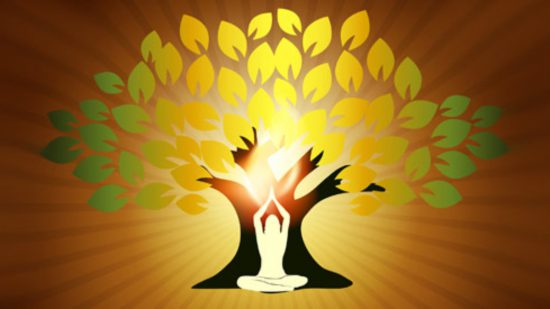How we can use karma yoga to uplift our communities
Ancient yogic wisdom teaches that each of us is a part of the Whole, the Divine, Brahman. More than ever, in this pandemic moment we are reminded that we are like branches on a tree, affected by the actions and decisions of one another.

This pandemic has caused suffering and trauma on a mass scale. Millions of people have lost their lives, many who have had covid will experience long-term impacts on their health, hundreds of thousands have lost their livelihood and homes—everyone’s lives have been disrupted like never before. The economic, social, and psychological fallout will surely be felt for years to come. We need to remember that we are all one. We need to come together. Much will be asked of us as a human race. We will have to overcome social obstacles wrought by a deep mistrust of the “other” so that we can work together to problem-solve, to accept, to innovate, and to learn from our mistakes.
As yoga students and practitioners, we may know that, according to the Upanishads and as espoused by Krishna in the Bhagavad Gita, the path of selfless action—karma yoga, or the yoga of action—is a direct path to spiritual salvation. Seva, embedded in karma yoga, is a Sanskrit word meaning “selfless service.” Seva can guide us to show up in the world with radical empathy by giving us agency to positively affect our communities.
Each of us has the potential to instigate change; no action is too small, no offering too humble. As Malcolm X once said, “When ‘I’ is replaced with ‘we,’ even illness becomes wellness.”
There is so much work to do that it is natural to feel overwhelmed or unsure of how, where, and what to do. Here are some recommendations that may help you begin to practice seva.
Reflect: Seva is more than volunteering or charity, even though both are encompassed by it. Seva, when rooted in karma yoga, is action that stems from our innermost true selves. When we see and know ourselves, and the intentions underlying and driving our actions, our response and reaction patterns to external and internal stimuli, we are practicing svadhyaya (self-study). This ongoing polishing of the internal mirror can reveal how we show up in the world, in our families, and communities. Svadhyaya can also shine a light on how we want to show up, on the impact we want to create. As yoga practitioners, we delve into the impact of our actions, not merely our intentions.
Act: In the Bhagavad Gita, Krishna explains the tenets of karma yoga—that when we serve another in any and all ways, and the service stems from our deepest purpose, or dharma, it is true yoga. When we act without any expectation of outcome or external validation, maintaining equanimity through challenges, it is true yoga.
There are many ways we can do this in tangible and practical ways. We can volunteer and donate to causes that are dear to us. We can uplift and amplify voices that have been marginalized. We can learn and unlearn how we contribute to systems of oppression in our local communities. We can live lightly so we conserve, protect, and honor Mother Earth. We can continue to be engaged citizens and have challenging conversations with those who have different opinions. We practice yoga in our actions when we honor ahimsa, “non-harming,” actively aiming to reduce harm.
Connect: Seva is an embodied manifestation of the inherent connections we have with one another. It is not giving from a sense of ego (asmita), which Patanjali calls one of the obstacles (kleshas) to true liberation of the Self. Seva comes from the heart as we recognize our shared humanity, as we recognize the truth that when someone in our community suffers, we all suffer. Seva is an acknowledgment that liberation is a collective endeavor, and that as human beings we have actively or passively contributed, impacted, and/or benefited from our collective suffering. Yoga by definition is deep connection, and seva is rooted in connection rather than separation wrought by our ego-self.
Surrender: When we dedicate the fruits of our labor to God and we practice Ishvara pranidhana (surrender to the Divine), it is true seva, and true karma yoga. As human beings having a very human experience, it is natural for us to seek love and appreciation for our actions. However, we can practice not being attached to the outcome of our actions. We can practice surrendering our efforts to something that is outside our own personal gain, whether to the Divine or to a cause larger than ourselves.
Karma yoga is a revelation of our human potential and our unique and diverse roles. Our world right now needs us all to show up, radically reimagine a new world, and work together to heal from our collective suffering so our human tree flourishes, grows stronger, and stays rooted in all its humanity.
In the Rig Veda, the most ancient of all Vedas, the phrase vasudhaiva kutumbakam beautifully encapsulates the underlying premise and feeling of seva and karma yoga; it means “The world is one family.” May we collectively heal and thrive together as one Human Family.
yogaesoteric
June 21, 2021
